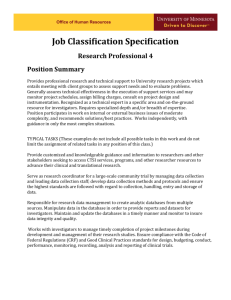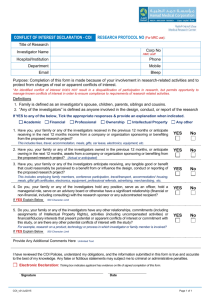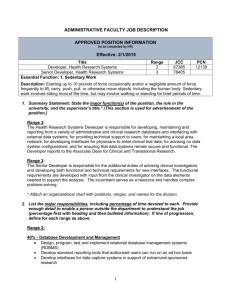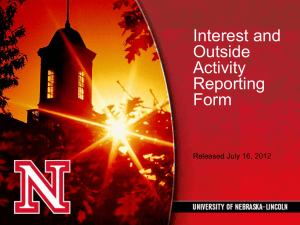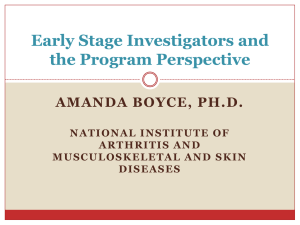The Role of Community Engagement in Translational Research
advertisement
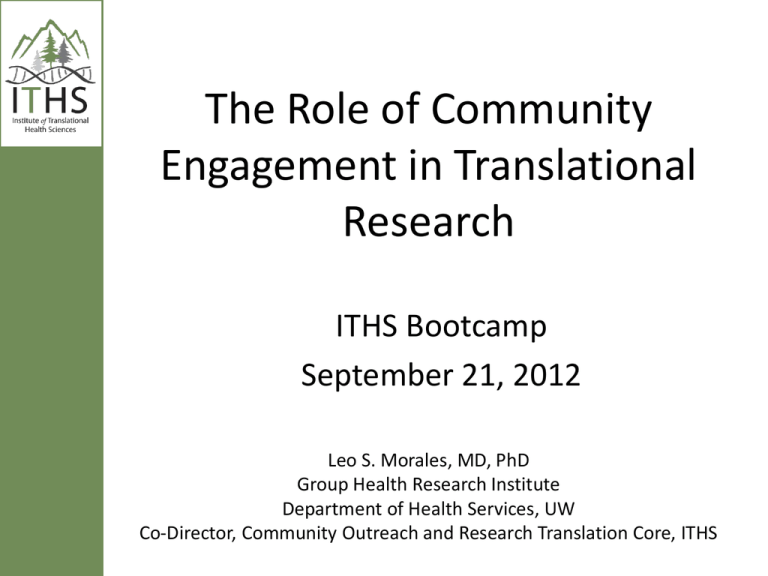
The Role of Community Engagement in Translational Research ITHS Bootcamp September 21, 2012 Leo S. Morales, MD, PhD Group Health Research Institute Department of Health Services, UW Co-Director, Community Outreach and Research Translation Core, ITHS Translational Research Continuum T1 Basic Research T2 Early phase Clinical Trials Translating discoveries into treatments (phase 1 and 2 clinical trials) T3 Later phase clinical trials Developing treatment guidelines (phase 3 clinical trials) T4 Community Practice Disseminating and implementing evidence-based care in practices Community Disseminating and implementing evidence-based interventions in communities What is Community Engaged Research? Community-engaged research is a framework or approach for conducting research that entails involving users of the research and other stakeholders in the formulation as well as the application of the research. A wide range of research methods—epidemiologic, experimental, survey, focus-group, qualitative interview—can be applied in the service of participatory research. The choice depends on the methods called for by the research questions and the feasibility of the methods in the particular circumstances. What is a Community? A group of people with diverse characteristics who are linked by social ties, shared perspectives, and engage in joint action in geographical locations or settings. Source: MacQueen KM, McLellan E, Metzger DS, Kegeles S, Strauss RP, Scotti R, Blanchard L, Trotter RT. What Is Community? An Evidence-Based Definition for Participatory Public Health. American Journal of Public Health. 2001; 91(12): 1929-1938. Contrasting Research Paradigms Traditional Research Community Engaged Research Community Based Participatory Research Research Objective Investigators set the research agenda Investigators set the research agenda with community input Investigators and community set research agenda Study Design Investigators design study Investigators design study with community input Investigators and community design study together Recruitment Investigators determine recruitment strategies Investigators select recruitment strategies with community input Investigators and community select recruitment strategies Data Collection Investigators select data collection strategies. Investigators select data collection strategies with community input. Community members assist with some aspects of data collection. Investigators and community select data collection strategies. Community members collect data - focus on capacity building Analysis/Interpret ation Investigators conduct analyses and interpret data Investigators conduct analyses and interpret data with community input Investigators and community conduct analyses and interpret data. Dissemination Peer-reviewed publications and scientific meetings Peer-reviewed publications, scientific meetings and community presentations Community members involved in all dissemination efforts including peer-reviewed publications. Participation of Different Groups in Translational Research Patients, Families, Communities Academic Investigators T1: Basic Research T2, T3: Clinical Trials T3, T4: Dissemination and Implementation Research Health Systems & Practices Degree of Participation by Stakeholders by Type of Research Source: Green LW, Mercer SL. Can public health researchers and agencies reconcile the push from funding bodies and the pull from communities? Am J Public Health. 2001 Dec;91(12):1926-9. Principles of Community Engagement • Have a clear statement of the purpose or goals of the engagement effort • Define the community or population you wish to engage • Become knowledgeable about the community or population you wish to engage • Go to the community, establish relationships, build trust, and seek commitments from community organizations and leaders to move the engagement process forward • Approach community members with humility and respect, recognizing the expertise and resources they can bring to a research project Adapted from: Principles of Community Engagement, 2nd Edition, June 2011 Principles of Community Engagement • Recognize that communities are diverse. Awareness of various factors affecting diversity must be considered when planning, designing and implementing community engagement • Seek to identify and mobilize community assets and develop a community’s capacity to make decisions and take action (build social capital) • Be prepared to adapt your methods and interventions to meet the needs of the community • Be prepared to make long-term commitments to community partners Adapted from: Principles of Community Engagement, 2nd Edition, June 2011 Community Engagement Continuum Barriers to Community Participation in Research • History of poor relationships with academic researchers – Topics of research not of interest – Results of research not shared with community – Community members subjects of experimentation • Limited time and resources for research • Limited experience proposing or conducting research • Lack of tangible benefits to community Barriers to Academic Participation in Community Engaged Research • Insufficient time to build relationships with community members and organizations • Community engagement may not recognized or rewarded by academic faculty • NIH funding is not suited to ongoing community engagement – Long and uncertain application process – Project-based funding • Communities may not be willing to wait for published articles to learn about the results of research ITHS CORT (Community Outreach and Research Translation) • Community Based Practice Research: UW Department of Family Medicine (Laura Mae Baldwin lmb@fammed.washington.edu) • American Indian/Alaskan Native Community Outreach: Partnership for Native Health (Dedra Buchwald dedra@uw.edu) • Hispanic Community Outreach: Group Health Research Institute (Leo Morales morales.l@ghc.org) Resources for Learning More About Community Engagement • • • • • • • • Principles of Community Engagement, 2nd Edition, Clinical and Translational Science Awards Consortium Viswanathan, M., Ammerman, A., Eng, E., et al., (eds). (2004). Community-Based Participatory Research: Assessing the Evidence. Rockville, MD: Agency for Healthcare Research and Quality. Minkler, M. and Wallerstein, N. (eds). (2008). Community-Based Participatory Research for Health: From Process to Outcomes (2nd edition). San Francisco, CA: Jossey-Bass. Research Toolkit (http://www.researchtoolkit.org/) Israel, B., Eng, E., Schulz. A., et al., (eds). (2005). Methods in community-based participatory research for health. San Francisco, CA: Jossey-Bass. Wallerstein N, Duran B Community-based participatory research contributions to intervention research: the intersection of science and practice to improve health equity American Journal of Public Health 2010;100(Suppl 1):S40-46 Seifer, S.D. and Calleson, D.C. (2004). Faculty perspectives on community-based research in academic health centers: Implications for policy and practice. Journal of Interprofessional Care. 18(4): 63-74. Office of Behavioral and Social Sciences Research, NIH (http://obssr.od.nih.gov/scientific_areas/methodology/community_bas Levels of Participation of Different Groups in Participatory Research Source: Green LW, Mercer SL. Can public health researchers and agencies reconcile the push from funding bodies and the pull from communities? Am J Public Health. 2001 Dec;91(12):1926-9.
